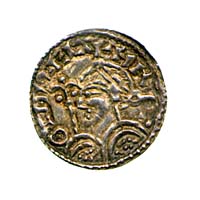March 17, 1040: Death of King Harold Harefoot
 Two years after the death of Oliver Cromwell, his body was exhumed from Westminster Abbey, hanged at Tyburn until sunset, and then re-buried at the foot of the gallows. The behaviour was not unprecedented: after the death of King Harold Harefoot, his successor King Harthacnut had Harold's body dug up (also from Westminster) and thrown into a fen.
Two years after the death of Oliver Cromwell, his body was exhumed from Westminster Abbey, hanged at Tyburn until sunset, and then re-buried at the foot of the gallows. The behaviour was not unprecedented: after the death of King Harold Harefoot, his successor King Harthacnut had Harold's body dug up (also from Westminster) and thrown into a fen.
Harold and Harthacnut had been engaged in a civil war a few years earlier, after the death of their father King Cnut, the Danish conqueror of England, in 1035. Harthacnut was certainly the son of Cnut by his Norman queen, Emma. Harold's parentage is more uncertain: the Anglo-Saxon Chronicle reports that he was the son of Cnut by an ealdorman's daughter, though one version flatly denies the claim. The problem that faced the English on Cnut's death was that, regardless of slurs on Harold's parentage, his half-brother Harthacnut was in Denmark, securing Cnut's Danish kingdom, and was unable to leave immediately to secure England as well. The English nobles north of the Thames (led by Earl Leofric) wanted Harold as lord of England, for himself and as deputy for his absent brother; those south of the Thames, in Wessex, led by Earl Godwine and Queen-mother Emma, preferred Harthacnut.
At first there was stand-off. Then, in 1036, the Chronicle reports that opinion was veering towards Harold. In 1037, when Harthacnut was still unable to return from Denmark, Harold was accepted as sole king over all England, and Emma was driven into exile. Almost nothing is known of Harold's short reign; after his death in 1040, the English sent to Bruges for Harthacnut. The nickname "harefoot" (implying swift-footed, like a hare) is not recorded before the late middle ages, but the fact that he was quick to be on the spot after Cnut's death (in marked contrast to his half-brother in Denmark) would have made the comparison painfully obvious, and it might be contemporary.
Review the history, 1035-40.